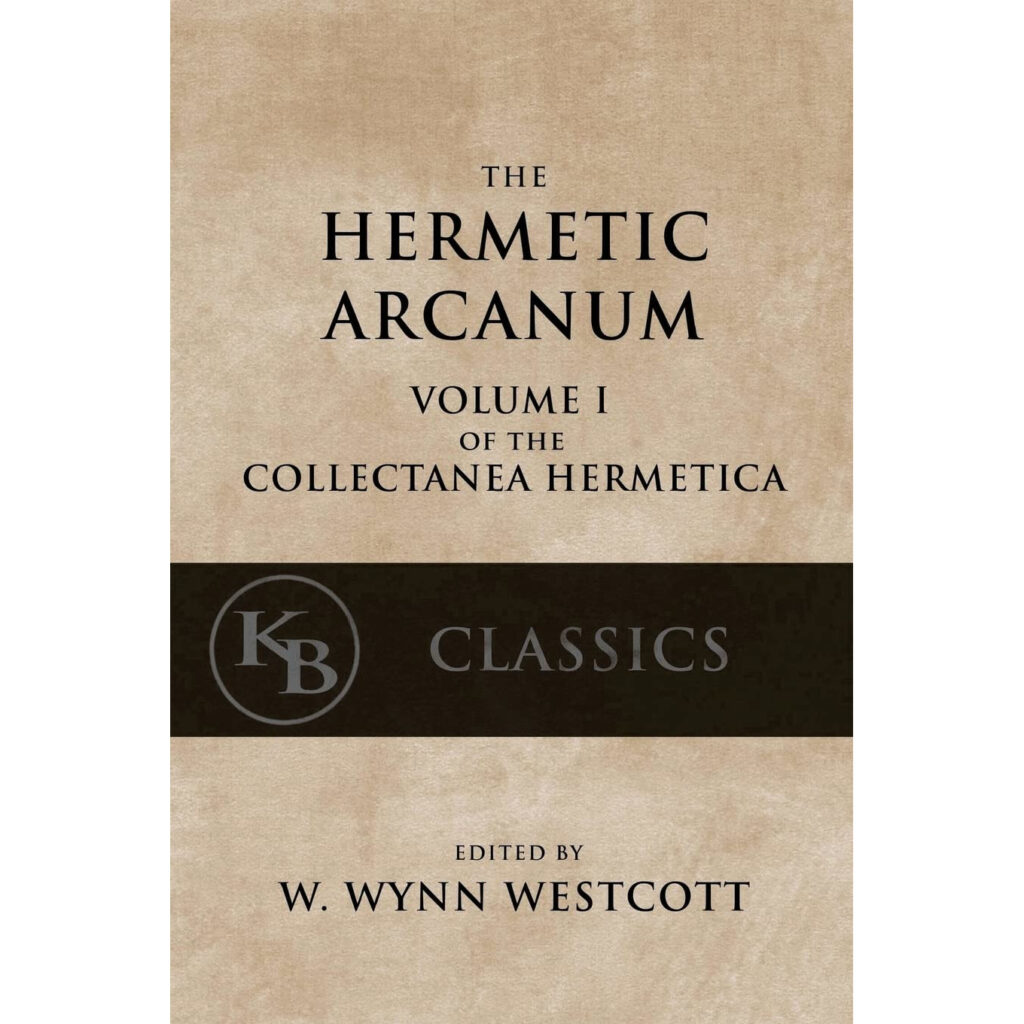Review of Collectanea Hermetica, Volume I: Hermetic Arcanum
Editor: Westcott, W. Wynn
The opening volume of W. Wynn Westcott’s Collectanea Hermetica occupies a special place in the canon of English Hermetic publishing. First issued in London in 1893 under Westcott’s editorship, it inaugurates the series with a tract whose influence had already spanned centuries: Jean d’Espagnet’s Arcanum Hermeticum (1623).
Editorial Frame
Westcott, writing under his Rosicrucian motto Sapere Aude, conceived this series as a corrective to the scarcity of reliable editions of early Rosicrucian and Hermetic texts. His Preface situates the project in a community of late-Victorian esotericists—members of the Societas Rosicruciana and allied students of Kabalah, Alchemy, and “Higher Magic.” Westcott stresses that the notes are aimed at readers with some prior immersion in Hermetic philosophy, not casual curiosity seekers, and his caveat that much is “reveiling” rather than “revelation” captures the dual purpose of the enterprise: to preserve the aura of secrecy while providing genuine historical material
The Text and Its Author
The Hermetic Arcanum itself, first published anonymously in Latin with the cryptic signature Penes nos unda Tagi (“By us flows the Tagus’ wave”), is almost certainly the work of Jean d’Espagnet, magistrate of Bordeaux and noted alchemical philosopher. Espagnet (fl. 1600–1630) embodied both the mystical temperament and the jurist’s rigor. He ornamented his Bordeaux residence with allegorical sculptures, contributed verses to anti-witchcraft treatises, and left only two known works: Enchiridion Physicae Restitutae and the Arcanum Hermeticum. The first explores natural philosophy and the possibility of transmutation; the second, chosen here, codifies the praxis of alchemy
Espagnet’s choice of mottoes—anagrams containing both his name and cabalistic formulations—reflects the Rosicrucian penchant for concealment. His tract was rapidly disseminated in Latin, French, and German, absorbed into Manget’s Bibliotheca Chemica Curiosa and Albineus’ Bibliotheca Chemica, and translated into English by Elias Ashmole (under the pseudonym Mercuriophilus Anglicus) in 1650. Westcott considered reprinting Ashmole wholesale but, finding the language both inaccurate and occasionally indelicate for Victorian sensibilities, produced a careful revision
Philosophical Core
The Arcanum is not a recipe book for wealth-seekers but a guide for the aspirant who has purified heart and intention. Its opening canons insist that the science begins with reverence for God and ends in charity, that it demands detachment from worldly affairs, and that it thrives only in the soul illuminated by divine light. Espagnet delineates the pitfalls of the laboratory—“innumerable sublimations, distillations, and solutions” that distract rather than enlighten—and places his faith in the via naturae, the plain way of Nature and Truth.
The treatise unfolds in numbered canons that interweave admonitions with technical doctrine. Espagnet stresses that alchemy is simultaneously cosmological and practical: the Stone is wrought not only to transmute metals but to heal bodies and souls, to liberate the imprisoned, to support temples and hospices. His language constantly merges the metallurgical with the mystical. Sol and Luna are both celestial bodies and archetypal principles; their “marriage” symbolizes the uniting of opposites, yielding a nobler offspring than either parent alone.
Mercury, the ever-elusive principle, is described in shifting guises: sublimated, chaotic, rebis, or even the perfected Elixir itself. The seeker is warned that philosophers veil their meanings in equivocal terms, sometimes speaking most truthfully when obscure. Espagnet anchors his exposition in a tripartite structure—sublime, mean, and gross matter—linked to the Hermetic elements and the Kabbalistic worlds. He insists that the entire Work is an imitation of Nature, echoing the Creation itself: chaos yielding to light, the elements separating, life arising.
Symbolic Imagery
One of the enduring qualities of the Arcanum is its imagery: the Crow’s head of putrefaction, the White Swan, the red and white tinctures, the garden of violets, lilies, and amaranths watered by the golden river. The adept must tame the Hesperian Dragon, navigate the union of Eagle and Lion, and observe the rainbow hues that flash and vanish in the vessel. These allegories link the laboratory process to biblical creation, mythic metamorphosis, and poetic emblem.
Historical Resonance
For Westcott’s Victorian readership—members of the Golden Dawn and the wider occult revival—the reissue of Arcanum Hermeticum served multiple functions. It offered an authoritative text in accessible English, reinforced the lineage of Rosicrucian wisdom, and provided a shared symbolic language for ritual and meditation. In retrospect, its publication also marked a key moment in the transmission of Continental alchemical philosophy into the Anglophone esoteric milieu, ensuring Espagnet’s influence upon modern Hermetic thought.
Critical Appraisal
As literature, the Hermetic Arcanum is a paradox: simultaneously clear and deliberately obscure. Its sequence of canons provides structure, but its language frustrates literalists. Westcott’s editorial apparatus—notes from Bacstrom, anonymous adepts, and himself—supplies cross-references but rarely demystifies. The enduring value of the volume lies less in its practical utility for chemical experiment than in its emblematic power: it is a text of aspiration, designed to test, purify, and inspire.
In the context of the Collectanea Hermetica, this first volume sets the tone: erudite, historical, reverent, yet uncompromising in its assumption that only the devoted and spiritually prepared will benefit. For modern readers, it remains both a document of the seventeenth-century Rosicrucian current and a cornerstone of the late nineteenth-century Hermetic revival.
Read it online here.
Hold it in your hands.
Research Snapshot: Collectanea Hermetica, Volume I – Hermetic Arcanum
Primary Work: Arcanum Hermeticum (Hermetic Arcanum)
-
Original Author: Jean d’Espagnet (fl. 1600–1630)
-
Probable Identity: President of the Parliament of Bordeaux; magistrate, natural philosopher, Hermeticist.
-
Publication: First Latin edition, France, 1623.
-
Motto/Signature: Penes nos unda Tagi (“By us flows the wave of the Tagus”), an anagram of Espagnet’s name.
-
Other Motto: Spes mea in Agno est.
-
Content: Structured in numbered canons, combining moral admonitions with practical and symbolic alchemical doctrine.
-
Themes: Marriage of Sol and Luna, Mercurial doctrine, stages of putrefaction (Crow, Swan, Red King), union of Art and Nature, cosmological parallels with Creation.
Subsequent Editions:
-
Latin editions reprinted in Geneva, Kiel, Lübeck, Tübingen, Leipzig.
-
French translation by Jean Bachon (1651).
-
German edition, Leipzig (1685), titled Das geheime Werck der Hermetischen Philosophie.
-
Included in Manget’s Bibliotheca Chemica Curiosa (1702) and Albineus’ Bibliotheca Chemica.
English Translations:
-
Elias Ashmole (as Mercuriophilus Anglicus), The Hermetic Arcanum, 1650 (3rd ed. noted by Westcott).
-
Revised and edited by W. Wynn Westcott, 1893, as Collectanea Hermetica, Volume I.
Editor: W. Wynn Westcott (1848–1925)
-
Supreme Magus, Societas Rosicruciana in Anglia.
-
Co-founder of the Hermetic Order of the Golden Dawn.
-
Motto: Sapere Aude.
-
Added notes from himself, Sigismund Bacstrom, and anonymous adepts.
-
Intention: To provide scarce Rosicrucian and Hermetic tracts for serious students.
Historical Context:
-
Espagnet contributed to anti-sorcery prosecutions in Les Landes and Pyrenees (1612 context).
-
Decorated his Bordeaux residence with Hermetic allegories (later preserved in mayoral gardens).
-
Philosophical position: rejected Aristotle, preferred Alexandrian and Hermetic cosmology; posited one universal hyle (prima materia).
Reception & Legacy:
-
Widely read, repeatedly reprinted.
-
Served as a cornerstone text in Rosicrucian alchemical circles.
-
Central to Victorian occult revival via Westcott’s Collectanea Hermetica.
-
Symbolic and allegorical structure ensures enduring value to mystics and historians rather than practical chemists.

